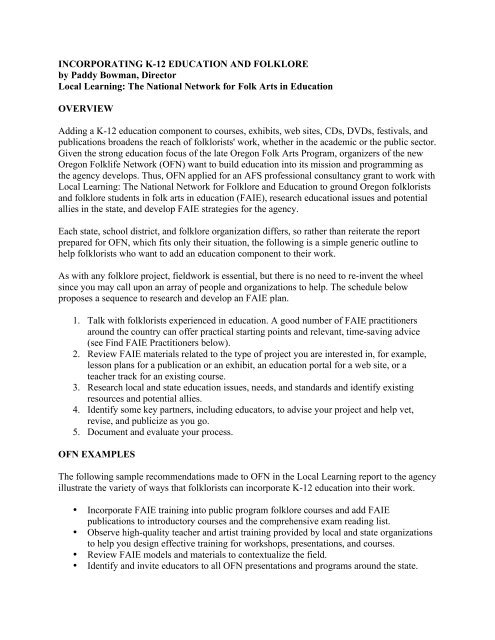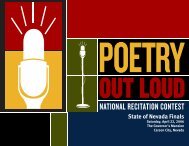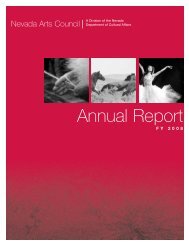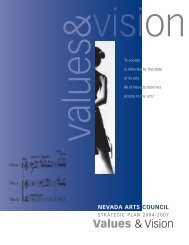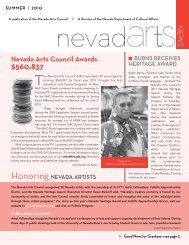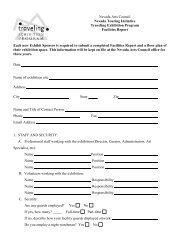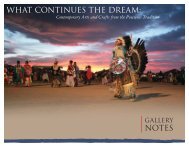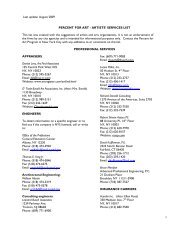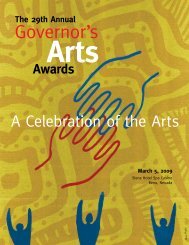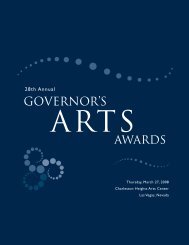INCORPORATING K-12 EDUCATION AND FOLKLORE by Paddy ...
INCORPORATING K-12 EDUCATION AND FOLKLORE by Paddy ...
INCORPORATING K-12 EDUCATION AND FOLKLORE by Paddy ...
You also want an ePaper? Increase the reach of your titles
YUMPU automatically turns print PDFs into web optimized ePapers that Google loves.
<strong>INCORPORATING</strong> K-<strong>12</strong> <strong>EDUCATION</strong> <strong>AND</strong> <strong>FOLKLORE</strong><strong>by</strong> <strong>Paddy</strong> Bowman, DirectorLocal Learning: The National Network for Folk Arts in EducationOVERVIEWAdding a K-<strong>12</strong> education component to courses, exhibits, web sites, CDs, DVDs, festivals, andpublications broadens the reach of folklorists' work, whether in the academic or the public sector.Given the strong education focus of the late Oregon Folk Arts Program, organizers of the newOregon Folklife Network (OFN) want to build education into its mission and programming asthe agency develops. Thus, OFN applied for an AFS professional consultancy grant to work withLocal Learning: The National Network for Folklore and Education to ground Oregon folkloristsand folklore students in folk arts in education (FAIE), research educational issues and potentialallies in the state, and develop FAIE strategies for the agency.Each state, school district, and folklore organization differs, so rather than reiterate the reportprepared for OFN, which fits only their situation, the following is a simple generic outline tohelp folklorists who want to add an education component to their work.As with any folklore project, fieldwork is essential, but there is no need to re-invent the wheelsince you may call upon an array of people and organizations to help. The schedule belowproposes a sequence to research and develop an FAIE plan.1. Talk with folklorists experienced in education. A good number of FAIE practitionersaround the country can offer practical starting points and relevant, time-saving advice(see Find FAIE Practitioners below).2. Review FAIE materials related to the type of project you are interested in, for example,lesson plans for a publication or an exhibit, an education portal for a web site, or ateacher track for an existing course.3. Research local and state education issues, needs, and standards and identify existingresources and potential allies.4. Identify some key partners, including educators, to advise your project and help vet,revise, and publicize as you go.5. Document and evaluate your process.OFN EXAMPLESThe following sample recommendations made to OFN in the Local Learning report to the agencyillustrate the variety of ways that folklorists can incorporate K-<strong>12</strong> education into their work.• Incorporate FAIE training into public program folklore courses and add FAIEpublications to introductory courses and the comprehensive exam reading list.• Observe high-quality teacher and artist training provided <strong>by</strong> local and state organizationsto help you design effective training for workshops, presentations, and courses.• Review FAIE models and materials to contextualize the field.• Identify and invite educators to all OFN presentations and programs around the state.
• Distribute to teachers at presentations the free 30th Anniversary National HeritageFellowships 1982-2011 publication and DVD-Rom, produced <strong>by</strong> Documentary Arts,featuring a PDF of the Masters of Traditional Arts Education Guide. Order single copiesfrom www.nea.gov/pub/pubCat.php?cat=Folk%20and%20Traditional%20Arts or contactthe NEA Folk and Traditional Arts Program for bulk orders.• Provide a roster of FAIE resources on the OFN web site.• Collaborate with Oregon tribes to help develop and disseminate authentic Indianeducation resources for students.• Establish relationships with the University of Oregon College of Education to findcommon ground and cross list courses, for example, ethnography.• Create an FAIE learning community across departments and community organizationsand include students from various departments as well as faculty and staff.THE BRASS TACKSAgain, each situation will differ, so here are some broad strokes to help paint a picture of howFAIE can be easily integrated into the work of folklorists.1. Find FAIE PractitionersLocal Learning: The National Network for Folk Arts in Educationhttp://www.locallearningnetwork.org is a loose association of folklorists, educators, and artistsworking in education in a variety of in-school and out-of-school settings. Contact the director,<strong>Paddy</strong> Bowman, paddybowman@verizon.net to find an FAIE practitioner in your region.The AFS Folklore and Education Section is another way of identifying people to help you.Contact the conveners at http://www.afsnet.org/default.asp?page=FolkloreEd.National Endowment for the Arts specialists in Arts Education (for example, Terry Liu) and BillMansfield and Barry Bergey in Folk and Traditional Arts may also be able to point you topeople, model projects, and resources. Find contact info at http://www.nea.gov.2. Review FAIE ResourcesExamine the Education Resources below, which offer an array of model FAIE web sites andguides.Study the Local Learning web site http://www.locallearningnetwork.org, paying special attentionto articles in the Library, organizations and materials in Regional Resources, National HeritageFellows' profiles and classroom connections in Guest Artists, and strategies for teachinginterviewing in Tools.Folklife Resources for Educators http://www.loc.gov/folklife/teachers/index.html is an AmericanFolklife Center portal that allows users to search for free online FAIE materials <strong>by</strong> region, genre,and subject. Review examples of a variety of guides.
Join the AFS Folklore and Education Sectionhttp://www.afsnet.org/default.asp?page=FolkloreEd to access the archive of newsletters, whichfeature new FAIE resources each issue. Annual dues are $10. Members do not have to join AFS.3. Research Education Issues, Needs, and StandardsEach state department of education has curriculum specialists who can brief you on currentissues, textbooks, and practices. Link to your state department of education through this U.S.Department of Education portal: http://www2.ed.gov/about/contacts/state/index.htmlIn addition to national education standards in each discipline, each state has standards thatteachers must help students meet, so resources must address standards in at least one discipline.Since folklore is inherently interdisciplinary, FAIE practitioners work across curricula. Link tostate education standards through this Education World portal:http://www.educationworld.com/standards/state/index.shtmlLocal school districts have curriculum specialists for most disciplines who can be helpful incontextualizing what students must study and identifying possible points of entry. For example,state history is often taught in 4th and 8th grades and may include culture, art, or heritagestandards that folklore fits well.4. Find Allies and PartnersSchools of education at local colleges and universities may be useful. Courses such as SocialFoundations of Education and ethnography are a good fit. Also faculty for various disciplinessuch as English language arts and social studies can advise you.State affiliates of national education associations may provide venues for presentations andworkshops as well as help in recruiting teachers (see Selected National Education Organizationsbelow).State and local arts agencies have arts education managers who are knowledgeable of local issuesand opportunities as well as schools and teachers who might make good partners.State and local humanities councils often provide professional development training for teachersthat might provide a venue and a model for good training.Museum education departments are often good allies.Research other education efforts such as place-based, heritage, and expeditionary education inyour area.Regional American Indian tribes and tribal councils may have education programs. The TribalEducation Department link might be useful in finding them http://www.tedna.org.
Local out-of-school education organizations such as weekend ethnic schools, 4-H http://www.4-h.org, and Boys and Girls Clubs http://www.bgca.org are other possible partners.<strong>EDUCATION</strong> RESOURCESSelected FAIE Web SitesNationalAmerican Folklife Center at the Library of Congress www.loc.gov/folklife see especially theEducators Guide to Folklife Resources.Local Learning www.LocalLearningNetwork.org advocates for inclusion of folk arts and artistsnationwide and provides virtual artist residencies with National Heritage Fellows, a library ofuseful articles for teachers, links to regional resources, and tools for engaging young people infieldwork and folklore. Find back issues of the annual CARTS Newsletter in the archive.Smithsonian Center for Folklife and Cultural Heritage www.folklife.si.edu has onlinecurriculum guides, exhibits, and the Smithsonian Folklife and Oral History Interviewing Guidein the Education portal. In addition, Smithsonian Folkways Recordings www.folkways.si.edufeatures music lessons in Tools for Teaching.The following entries offer models for several types of resources. Find many more on thenational web sites above.Teacher NetworksCenter for the Study of Upper Midwestern Culture http://csumc.wisc.edu supports theWisconsin Network for Teachers of Local Culture, cultural tours, and curriculum guides. Seeespecially the Cultural Tours portal to see how deeply students can connect with local culture.Discovering Community www.discoveringcommunity.org is a project of the Vermont FolklifeCenter that provides methods and resources to create locally designed curricula that support andmeet the pressing need for cultural conservation and civic participation. See especially DiscoveryProjects for model classroom projects.State and Regional GuidesIowa Folklife: Our People, Communities, and Traditions www.uni.edu/iowaonline/folklife isan award-winning online lifelong multimedia learning guide for all ages. A new volume is atwww.uni.edu/iowaonline/folklife_v2. Both guides include intergenerational connections, audio,and video and highlight an excellent way to incorporate fieldwork into education guides.Louisiana Voices: An Educator’s Guide to Exploring Our Communities and Traditionswww.louisianavoices.org This comprehensive interdisciplinary Web-based guide with manylessons, essays, photos, video, and audio is public domain and adaptable for any region. From
student worksheets and assessment tools to dozens of lesson plans and student activities, thisguide has something for everyone and is useful in teaching any age group fieldwork.North Country Folklife www.northcountryfolklore.org is an educational web site of TraditionalArts of Upstate New York offering several themes through which users can explore the region:music, special places, foodways, oral traditions.Interdisciplinary, All GradesMasters of Traditional Arts Education Guide www.mastersoftraditionalarts.org featuresNational Heritage Fellows who are craftspeople, musicians, and dancers and templates for unitsof study such as Sense of Place or Sense of Discovery and numerous student activities.Social Studies, English Language Arts, Arts, Grades 3-8Wisconsin Folks www.wisconsinfolks.org teaches students about folk art and artists of that stateand provides examples of many genres and artists, from fish decoys to dance and links content tostate standards. The site also allows users to book artists for classroom residencies.Music, Pre-K to Grade 3Alabama Folklife Association www.alabamafolklife.org provides audio excerpts of children’ssongs recorded in 1947 in the online Bullfrog Jumped Children’s Folksongs Learning Guide forpre-K to grade 3.Music, High SchoolIntroduction to Irish Musichttp://media.smithsonianfolkways.org/docs/lesson_plans/ireland_songs.pdf allows students toexplore Irish and Irish-American history and culture through song lyrics, dance, and instrumentdemonstrations. They may follow the music and play along with melody sheets and bandtranscriptions.Visual Art, Grades 4 to <strong>12</strong> and CollegeFolkvine www.folkvine.org of the Florida Cultural Alliance gives users video, audio, and textoptions to explore folk artists of Florida, including bobble head dolls who represent real-lifescholars of the state’s traditional culture. From post-modern theory in themed online guides to aboard game for students, the site offers an array of ways to study folk artists and sense of place.Language Arts, Social Sciences, and Film, High School and CollegeFolkstreams www.folkstreams.net is a video-streaming site built as a national preserve ofAmerican folk culture documentaries and offers users extensive background materials for eachfilm. Use excerpts or entire films and the Educators Portal, which includes a very useful FilmAnalysis Worksheet.
Selected FAIE PublicationsThis list represents only a few FAIE books and publications for various age groups andsituations. For a more extensive bibliography, email paddybowman@verizon.net.Bowman, <strong>Paddy</strong>, and Lynne Hamer, eds. Through the Schoolhouse Door: Folklore, Community,Curriculum. Utah State University Press, 2011.Campbell, Patricia Shehan. Songs in Their Heads: Music and Its Meaning in Children's Lives.Oxford University Press, 1998.Congdon, Kristin, and Kitty Kitson Petterson, illustrator. Uncle Monday and Other FloridaTales. University of Mississippi Press, 2001.Govenar, Alan. Extraordinary Ordinary People: Five American Masters of Traditional Arts.Candlewick Press, 2006.Kirshenblatt-Gimblett, Barbara. An Accessible Aesthetic: The Role of Folk Arts and Folk Artistsin the Curriculum. New York Folklore 9(3-4), pp. 9-18, 1983. Retrieved fromwww.locallearningnetwork.org/library/the-archive.Lornell, Kip. Introducing American Folk Music. Brown and Benchmark, 1993.MacDowell, Marsha, and LuAnne Kozma. Folk Arts in Education: A Resource Handbook II.Michigan State University Museum, 2008. Order or download this extensive anthology of FAIEsamples from over 50 programs at www.folkartsineducation.org.Rosengarten, Dale, et al. Grass Roots: African Origins of an American Art. Museum for AfricanArt, 2009. Download at www.africanart.org/uploads/resources/docs/gr.pdf.Simons, Elizabeth Radin. Student Worlds, Student Words: Teaching Writing Through Folklore.Heinemann, 1990.Sunstein, Bonnie, and Elizabeth Chiseri-Strater. FieldWorking: Reading and Writing Research.2 nd ed., Bedford/St. Martin’s, 2002.Vermont Folklife Center. Children's Book Series features a number of high-quality picture booksbased on stories from the VFC archive. See http://www.vermontfolklifecenter.org/childrensbooks/index.shtml.Wagler, Mark, Ruth Olson, and Anne Pryor. Kids’ Guide to Local Culture and Teacher’s Guideto Local Culture. Madison Children’s Museum, 2004. Download athttp://csumc.wisc.edu/wtlc/?q=resources.Selected National Education Organizations
American Association of School Librarians (http://www.ala.org/ala/mgrps/divs/aasl)Arts Education Partnership (http://www.aep-arts.org)Association for Supervision and Curriculum Development (http://www.ascd.org)Kennedy Center Alliance for Arts Education (http://www.kennedy-center.org/education/kcaaen)MENC: The National Association for Music Education (http://www.menc.org)National Art Education Association (http://www.arteducators.org)National Council for the Social Studies (http://www.socialstudies.org)National Council of Teachers of English (http://www.ncte.org)National Council of Teachers of Mathematics (http://www.nctm.org)National Guild for Community Arts Education (http://www.nationalguild.org)National Science Teachers Association (http://www.nsta.org)National Writing Project (http://www.nwp.org)U.S. Department of Education (http://www.ed.gov)USDOE portal to state education departments and other organizations(http://www2.ed.gov/about/contacts/state/index.html)


